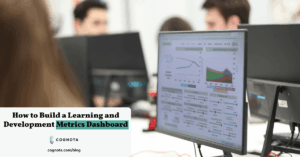We’ve written previously about the importance of creating a culture of learning—an environment in which opportunities to learn become a natural part of the daily work of every employee throughout the organization. This ‘learning in the flow of work’ makes learning natural and unobtrusive.
Learning shouldn’t disrupt the day’s work but rather enhance and even improve it. Employees may even look forward to short, on-the-job microlessons—especially when that content is laser-focused and relevant to the employee’s job and professional development.
On-the-job interactions among peers, teammates, and managers deliver value for everyone. In this year’s Global Human Capital Trends report, HR consulting firm Bersin by Deloitte found that organizations are moving towards a “joint ownership, joint accountability” model of workforce learning. In such scenarios, L&D and the business share responsibility for developing learning—even if that learning is short and built into daily workflows.
Years of Training with Just a Few Clicks?
Indeed, as we’ve written previously, YouTube, Facebook, Spotify, and other apps—and all accessible via mobile phones—have changed the way we consume and engage with content in general. Employes, and not just Millennials and GenZ, expect features that include Channels, Topics, Recommendations, and Featured Content, all designed to make it easy to find the next thing to consume.
“They are easy to use, attractive, and lead you from place to place. And this is the paradigm many learning platform vendors are using,” notes Josh Bersin in his blog.
Additionally, employees have less and less time for training. According to Training Magazine’s 2018 Training Industry Report, the time employees spend on training has actually been decreasing. Employees received on average 46.7 hours of training in 2018, compared to 47.6 hours in 2017. That’s less than one hour per week for training. As such, L&D and department managers need to make the most of employees’ time.
Solenis is a global provider of solutions to the pulp, paper, oil and gas, chemical processing, mining, biorefining, power, and municipal markets. Thomas Bernard, a senior manager and global learning leader for Solenis, is tasked with training a global commercial team of over 2,000 salespeople with very technical subject matter.
When Bernard joined Solenis, he learned that it currently takes 5 to 6 years to get a commercial team member fully trained to an effective level in all the competency areas in which he or she needs to be successful.
However, young new employees often do not stay with the company that long. He found himself asking, “How do we build an effective sales team when it takes longer to train them than they are even with the company?”
Historically, training meant multi-week, intensive classroom-based technical training marathons taught by senior Solenis applications experts. “The marathon training events were not effective, and the generation coming into the workforce have rebelled against these types of sessions in feedback to our CEO,” Bernard notes.

In the Flow of Work
Further, employees want to learn at the moment they need to know something to do their jobs better. According to LinkedIn’s 2018 Workplace Learning Report, 49 percent of employees prefer to learn at the moment of need.
For software engineering and technical teams, online books and job aids provide “instant support” when they have coding problems. Systems like GitHub, StackOverflow, O’Reilly Safari, and others have been essentially delivering learning in the flow of work already for several years.
Companies that can provide this type of learning environment will see outsized results.
However, we cannot simply rely on YouTube-like learning to address training challenges.
“We have to remember that corporate learning is very different from music and TV. We don’t watch learning to be entertained: we watch it to really learn something,” cautions Bersin.
Want to hear more about how Solenis’s “Learn it Now” strategy delivered award-winning results? Check out this recorded webinar!
“Learn It Now”
“I wanted to find a way to build just-in-time, mobile-friendly training opportunities that would provide the coaching for just that needed skill,” explains Bernard.
To address these issues—but still carry forth a just-in-time, at-the-moment, in the flow learning experience—Solenis turned to Cognota to create its own online eLearning modules by technical experts, without the need for subject matter experts to have training design expertise.
Working with Cognota, Bernard and his team developed “Learn it Now” modules for use right in the assessment platform. An employee can now review a competency assessment item and realize that he or she cannot change from the default “No” (either doesn’t know or can’t demonstrate that skill) to “Yes” (signifying “I know this and do not need training”).

“New employees can target their training to just what they need to know when they need to know it, wherever they are,” notes Bernard. “Experienced employees can still review individual skills if needed to freshen up their knowledge. Our technical experts can focus on helping our sales teams grow by providing technical support, instead of reading technical slides to a group of head-bobbing millennials in hotel classrooms.”
With Cognota, right at the assessment item, the employee can click the “Learn it Now” link, which opens a quick-hit training module in Cognota that provides relevant training immediately. Employees quickly acquire that knowledge or skill, and can now change the assessment item to “Yes” and attach evidence of their newfound skill or knowledge for a coach to review, and they can further reference it again in the future.
“I am pretty excited and passionate about the subject, and our progress, with what I feel is a pretty revolutionary way of developing new employees,” adds Bernard.
In this way, Solenis has created learning in the flow of work, making learning experiences seem natural and relevant to the employee’s workload. There are substantial savings in time and headaches, and everyone wins.
In sum, what we ultimately want to do is embed learning into the platform in which employees work. In this way, the systems can coach and train employees to perform better on the job.
And this learning in the flow of work “is where all this digital learning is likely to go,” adds Bersin.
Want to learn more about how Cognota can help you collaborate with SMEs to build courses faster?
Schedule a demo!




